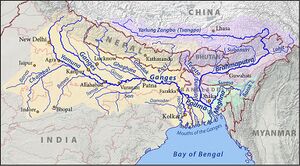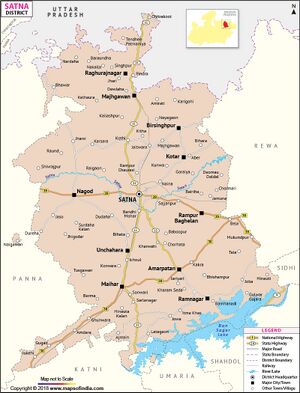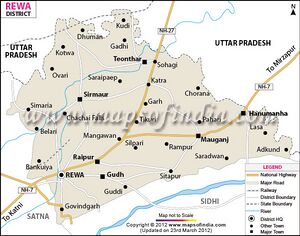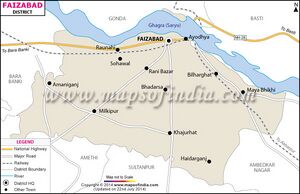Tamsa River
| Author:Laxman Burdak, IFS (R) |

Tamsa River (तमसा नदी) is a tributary of the Ganges flowing through the states of Madhya Pradesh and Uttar Pradesh in India.
Variants
- Tamas river
- Tamasa (तमसा) (AS, p.390)
- Tamas
- Tons/Tons River टौन्स दे. Tamasa तमसा (AS, p.379)
- Tamasa (तमसा) Mahabharata (VI.10.30)
- Tamas/Tamasa (तमसा) is also the Sanskrit name of Thames River of England. It is a matter of research how and when it got the Sanskrit name.
Course



The Tamas rises in a tank at Tamakund in the Kaimur Range at an elevation of 610 metres. Tons River originates in Satna District near village Barethi on NH-7, crosses again NH-7 east of Maihar, crosses Satna-Rewa road at Madhogarh enters Rewa district near Belari Rewa. The river meets Ganges after flowing 246 km in Madhya Pradesh, 7 km making boundary between Madhya Pradesh and Uttar Pradesh and finally 67 km in Uttar Pradesh.
It flows through the fertile districts of Satna and Rewa. At the edge of the Purwa plateau, the Tamas and its tributaries form a number of waterfalls. Total basin area in Madhya Pradesh is 11974 km². The river receives the Belan in UP and joins the Ganges at Sirsa, about 311 kms downstream of the confluence of the Ganges and Yamuna between Allahabad and Mirzapur. The total length of the river is 264 kms.
The Tamas River while descending through the Rewa Plateau and draining northwards makes a vertical falls of 70m known as Purwa Falls.[1] Some of the more notable waterfalls on the tributaries of the Tamas river, as they come down from the Rewa Plateau, are: Chachai Falls (127m) on the Beehar River, a tributary of the Tamas, the Keoti Falls (98m) on the Mahana River, a tributary of the Tamas, and Odda Falls (145m) on the Odda River, a tributary of the Belah River, which is itself a tributary of the Tamsa.[2]
In Ramayana
This river is mentioned in Ramayana. As this is the river on which Rama spent his first night during the 14 years of forest exile. When Rama left Ayodhya people followed him and were not ready to return to their homes. In the evening Rama, Lakshmana and Sita and all the people reached the banks of the Tamas. Rama and everyone agreed to spend the night at the banks of the Tamaas river and continue the journey next morning. Rama left people sleeping and continued the journey further.[3]
The Ashrama of sage Valmiki was at the banks of Tamaas river.[4] When Sita was exiled by Rama, she left Ayodhya and came to the banks of Tamas river some 15 km away from the city, where she met Valmiki. He requested Sita to live in his ashrama situated at the bank of the Tamas river. Here Sita spent all her remaining life, and here her twin sons Lava and Kusha received education and trained in military skills under the tutelage of Valmiki.[5]
Also on the banks of river Tamas was the ashram of Bharadwaja, mentioned in the Valmiki Ramayana; it is here that on seeing the plight a bird couple, Valmiki created his first verse, shloka.[6]
Towns on Tons (Tamsa) River
Towns and villages situated on Tamsa River are:
- Birute (Satna) on NH-7
- Dhatura (Satna)
- Maihar (Satna) in west
- Madhogarh (Satna) crosses Satna-Rewa road at Madhogarh
- Chibaura (Satna) in east
- Belari Rewa (Rewa) Near the border of Satna district.
- Kumhada (Rewa)
- Chachai Falls (Rewa)
- Khaidi (Rewa)
- Sitlaha (Rewa)
- Teonthar (Rewa)
- Malpar
- Chakghat
- Mau
- Azamgarh[7]
Tamsa went extinct
Tamsa went extinct nearly 50 years ago. The Tamsa banks, now dotted with 82 villages, before it flow into the Ghagra in Shrawan village of Ambedkarnagar finds a mention in Tulsidas's Ram Charitra Manas. Tamsa was once one of the three main rivers in central-eastern UP, including Ghaghra and Rapti. After the river dried up, land was encroached upon by farmers for cultivation.[8]
टौंस नदी
विजयेन्द्र कुमार माथुर[9] ने लेख किया है ... टौंस (AS, p.379) तमसा नदी अयोध्या (उत्तर प्रदेश) से प्राय: 12 मील दक्षिण की ओर बहती हुई लगभग 36 मील की यात्रा के पश्चात अकबरपुर के पास बिस्वी नदी में मिल जाती है. इस स्थान के पश्चात संयुक्त नदी की धारा का नाम टौंस हो जाता है. टौंस तमसा का ही बिगड़ा हुआ रूप है. तमसा का रामायण में उल्लेख है (दे. तमसा)
तमसा नदी
विजयेन्द्र कुमार माथुर[10] ने लेख किया है ... 1. तमसा नदी (AS, p.390): अयोध्या (उत्तर प्रदेश) के निकट बहने वाली एक छोटी नदी, जिसका उल्लेख रामायण में है। वन को जाते समय श्रीराम, लक्ष्मण और सीता ने प्रथम रात्रि तमसा नदी के तीर पर ही बिताई थी- 'ततस्तुतमसातींर रम्यमाश्रित्य राघव:, सीतामुद्वीक्ष्य सौमित्रमिदंवचनमव्रबीत्। इयमद्य निशापूर्वा सौमित्रे प्रहिता वनं वनवासस्य भद्रंते न चोत्कंठितुमर्हसि' (वाल्मीकि रामायण, अयोध्याकांड 46, 1-2)
वाल्मीकि रामायण, अयोध्याकांड (अयोध्याकांड 45, 32-33;46, 16;46, 28) आदि में भी तमसा नदी का उल्लेख है। अयोध्याकांड (46, 28) में वाल्मीकि ने तमसा को (शीघ्रगामाकुलवर्ता तमसामतरन्नदीम्) शीघ्र प्रवाहिनी तथा भंवरों वाली गहरी नदी कहा है। कालिदास ने 'रघुवंश' (9, 72-75) में, तपस्वी श्रवण की मृत्यु तमसा के तट पर वर्णित की है। उन्होंने तमसा के तीर पर तपस्वियों के आश्रमों का भी उल्लेख किया है, किंतु वाल्मीकि रामायण, अयोध्याकांड (63, 36) में इस दुर्घटना का सरयू नदी के तट पर उल्लेख किया गया है- 'अपश्यनिपुणा तीरे सरय्वास्तापसं हतम्, अवकीर्णजटाभारं प्रविद्धकलशोदकम्।'
वास्तव में सरयू और तमसा दोनों ही नदियाँ अयोध्या के निकट कुछ दूर तक पास ही बहती हैं। रघुवंश (14, 76) के वर्णन में विदित होता है कि वाल्मीकि का आश्रम, जहाँ राम द्वारा निर्वासित सीता रहीं थीं, तमसा के तट पर स्थित था- 'अशून्यतीरां मुनिसंनिवेशैस्तमोपर्हत्रीं तमसामवगाह्म, तत्सैकतोत्संगबलिक्रियाभि संपत्स्यते ते मनस: प्रसाद:।'
अयोध्या से इस आश्रम को जाते समय लक्ष्मण ने सीता सहित गंगा को पार किया था। (रघुवंश 14, 52)
रघुवंश (9,20) में तमसा नदी का उल्लेख सरयू के साथ है- 'त्रतुषु तेन विसर्जितमौलिना भुज समाहृत दिग्वसुनाकृत: कनकयूपसमृच्छयशोभिनो वितमसातमसा सरयूतटा:।' रघुवंश (9, 72) में भी तमसा को अयोध्या के निकट कहा गया है- 'तमसां प्राप नदीं तुरंगमेण।'
भवभूति ने उत्तररामचरित में तमसा का सुन्दर वर्णन किया है और वाल्मीकि का आश्रम, कालिदास की भांति ही तमसा नदी के तट पर बताया है- 'अथ स ब्रह्मर्षिरेकदा माध्यं दिनसवनायनदीं तमसामनुप्रपन्न:।' इस तथ्य की पुष्टि वाल्मीकि. आदि., 2,3-4 से भी होती है--'स मुहूर्तंगते तस्मिन् देवलोकं मुनिस्तदा जगाम तमसा तीरं जाह्नव्यासत्वविदूरत:, सतु तीरं समासाद्य तमसाया मुनिस्तदा, शिष्यमाह स्थित पार्श्व दृष्टवा तीर्थमकर्दमम्'।
तमसा नदी के तट पर ही वाल्मीकि ने निषाद द्वारा मारे जाते हुए क्रोंच को देखकर करुणार्द्र स्वरों में अनजाने में ही संस्कृत लोकिक साहित्य के प्रथम श्लोक की रचना की थी, जिससे रामायण की कथा का सूत्रपात हुआ। तुलसीदास ने तमसा का वर्णन राम की वनयात्रा तथा भरत के चित्रकूट की यात्रा के प्रसंग में किया है- 'तमसा तीर निवास किय, प्रथम दिवस रघुनाथ' तथा 'तमसा प्रथम दिवस करिवासू, दूसर गोमती तीर निवासू।'
आधुनिक स्थिति: आजकल तमसा नदी अयोध्या (फैजाबाद ज़िला, उत्तर प्रदेश) से प्राय: 12 मील दक्षिण में बहती हुई लगभग 36 मील की यात्रा के पश्चात् अकबरपुर के पास बिस्वी नदी में मिल जाती है। इस स्थान के पश्चात् संयुक्त नदी का नदी का नाम टौंस हो जाता है, जो तमसा का ही अपभ्रंश है। तमसा नदी पर अयोध्या से कुछ दूर पर वह स्थान बताया जाता है, जहाँ श्रवण की मृत्यु हुई थी। अयोध्या से प्राय: 12 मील दूर तरडीह नामक ग्राम है, जहाँ स्थानीय किवदंती के अनुसार श्रीराम ने वनवास यात्रा के समय तमसा को पार किया था। वह घाट आज भी रामचौरा नाम से प्रख्यात है। टौंस ज़िला, आजमगढ़ में बहती हुई बलिया के पश्चिम में गंगा में मिल जाती है।
2. तमसा (AS, p.391) मध्य प्रदेश में मैहर के पहाड़ों से निकल कर बुंदेलखंड के इलाके में बहने वाली एक नदी का नाम भी तमसा है जिसका उल्लेख महाराज सर्वनाथ के खोह अभिलेख (512 ई.) में है. इस नदी के तट पर आश्रमक नानक ग्राम का भी उल्लेख इस अभिलेख में है.
External links
References
- ↑ K. Bharatdwaj. Physical Geography: Hydrosphere. p. 161. Google books.
- ↑ K. Bharatdwaj. Physical Geography: Hydrosphere. p. 154. Google books.
- ↑ "At the banks of the Tamsa River". The Story of Valmiki Ramayan.
- ↑ Vishvanath Limaye (1984). Historic Rama of Valmiki. Gyan Ganga Prakashan.
- ↑ History Of Mittal, J.P. (2006). History of Ancient India: From 7300 BC to 4250 BC (Volume 1). Atlantic Publishers & Distributors. p. 368. ISBN 81-269-0615-4.
- ↑ Kala, Jayantika (1988). Epic scenes in Indian plastic art. Abhinav Publications. p. 7. ISBN 81-7017-228-4.
- ↑ Azamgarh District Website
- ↑ Extinct Tamsa of Ramayana lore being revived in Ayodhya, TOI,7.1.2019
- ↑ Aitihasik Sthanavali by Vijayendra Kumar Mathur, p.379
- ↑ Aitihasik Sthanavali by Vijayendra Kumar Mathur, p.390-91
Back to Rivers in Ramayana

